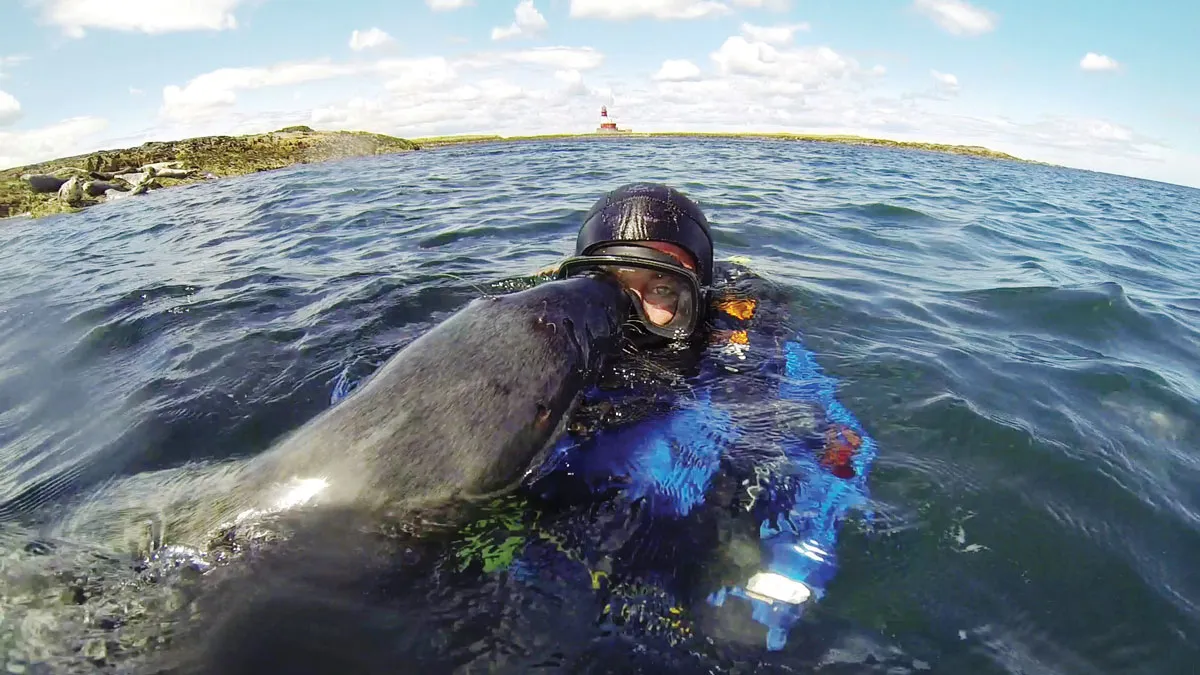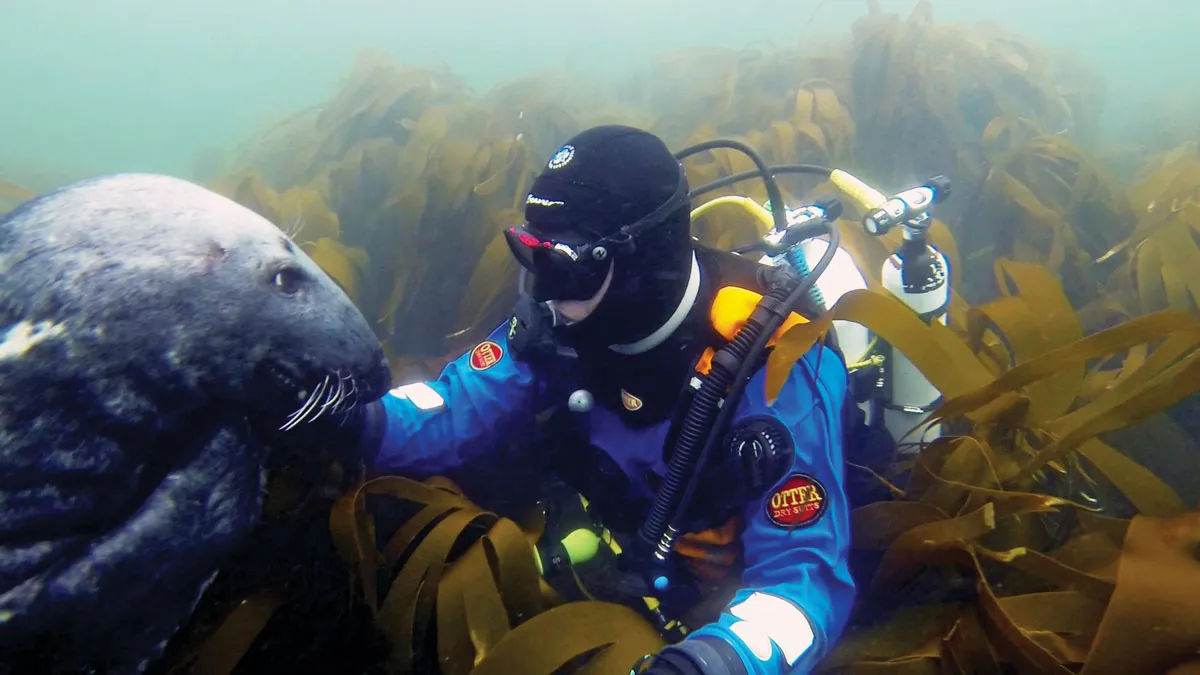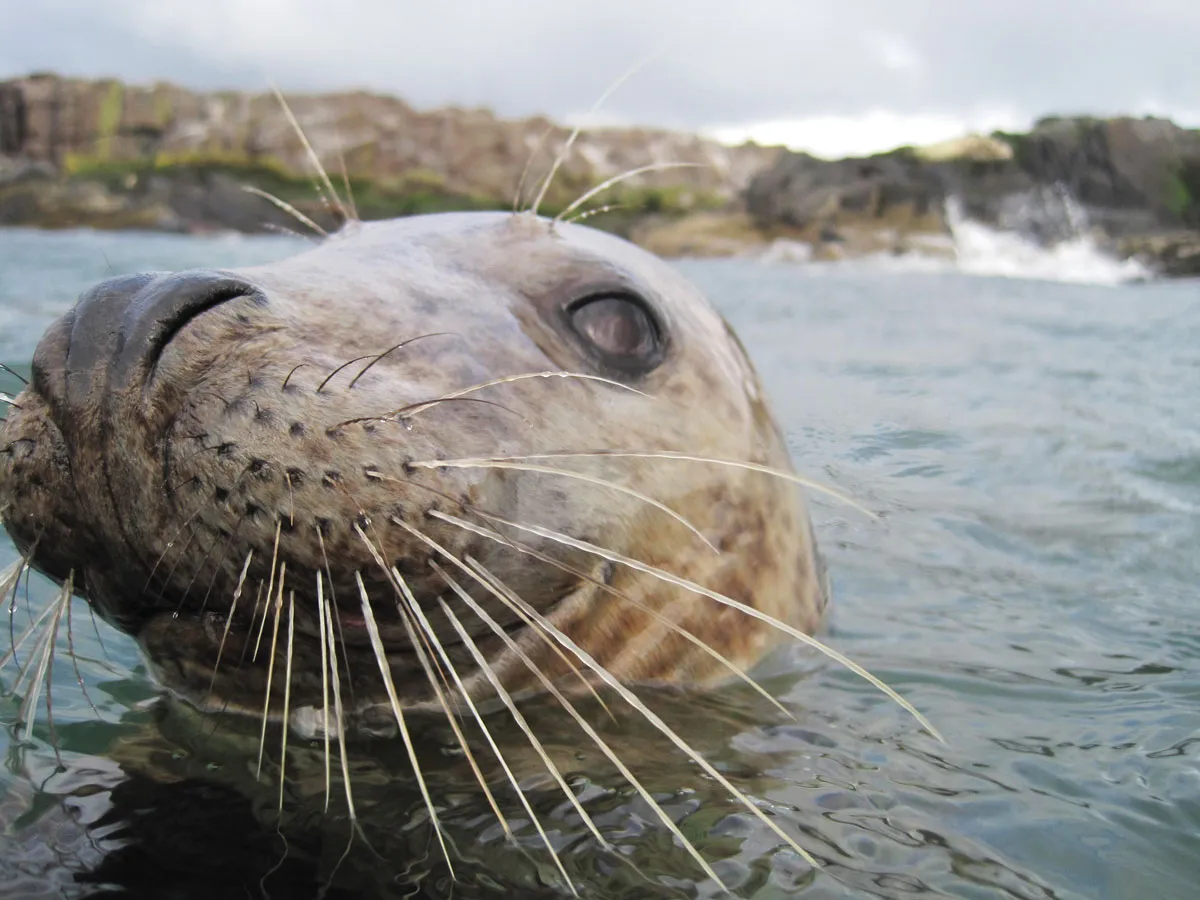Wave after wave of tranquillity washes over me as Glad Tidings 7 pulls away from its mooring and heads north east towards the Farne Islands, a few miles from Northumberland’s Seahouses harbour. Salty air blows freshly from the east, stirring white horses as the boat glides to a halt off the Longstone lighthouse, famous for the heroic acts of Grace Darling in 1838.

The other divers on the boat may think that I’m diving solo, but as I sink beneath the waves I’m far from alone. My ‘dive buddies’ greet me with large brown eyes bisected with vertical pupils that can open dramatically to allow vision in very low light conditions.
Their grace and speed make my swimming efforts look feeble and while they can hold their breath for more than 20 minutes, I need a cylinder of compressed air strapped to my back in order to breathe. With large amounts of oxygen-carrying myoglobin in their muscles and the ability to slow their heart rate to below 10 beats per minute, my companions – grey seals – can dive to over 300m.
One of them approaches and gently presses its soft, leathery nose against my mask. I look deeply into the eyes of my companion who stares back, unblinking. My breathing stops.

In fact, time itself seems to stop and, for a moment, there’s complete calm. This connection with nature can’t truly be described with words, it must be felt; it’s like a magical stillness that wraps around you, a moment of silence in a sea that’s far from quiet.
A deep bass sound reverberates through my chest as another grey seal calls out ahead. This is a large bull, a male weighing up to 300kg.

The sound seems to attract the female seals who investigate the bull that’s suspended in the water with perfectly balanced buoyancy.
A grey seal bull is a formidable carnivore and is the largest wild animal to breed on British soil. But these charismatic creatures have two very different sides.
Hauled out onto land a grey seal is cumbersome and defensive, but underwater that same seal is inquisitive and completely at one with its surroundings. I’ve often found myself on dives where I’m struggling to make any sort of headway against strong currents only to turn and see seals move effortlessly against the weight of the water.

The UK coast is home to roughly 38% of the world’s population of grey seals (Halichoerus grypus) – some 110,000 individuals. This is significant from a conservation standpoint when you think that there are fewer grey seals in the world than African elephants. Particularly given these robust mammals are able to flourish in a harsh marine environment that brings daily challenges.
Thriving in tough conditions
Born on rocky outcrops or in sheltered coves, a typical grey seal pup weighs 15kg. For the next three weeks this pup suckles maternal milk that’s very high in fat and typically puts on a further 30kg, tripling its birth weight. During this early stage the pups are vulnerable to birth complications and trauma from other seals.
After three weeks, the pups tend to form small groups known as weaner pods that remain on land while the mothers return to the sea to feed. After a week or two the pups eventually take their first swim in the sea and start the treacherous journey to adulthood. Pup mortality is high and only half of the newborn pups reach maturity.
Males can live for more than 25 years and will begin breeding by the time they’re eight years old, while females start breeding after five years and can live up to 46 years.
During the course of their lives seals face danger in the forms of starvation, respiratory infections and getting trapped in fishing gear. Offshore there’s also the threat of predation from orcas or even sharks. Life for a grey seal is tough and these beautiful creatures have to be exceptionally hardy to get through it.
But seals are remarkably well adapted to their environment and have developed some truly impressive senses to help them thrive in it. They can taste minute variations in seawater salinity and smell a chemical released when zooplankton feed on phytoplankton, both indicators of potentially rich feeding areas.
Their whiskers are also capable of detecting hydrodynamic trails left in the water from swimming fish. Homing in on these trails, their large light-sensitive eyes allow them to see in near darkness and their mouths are armed with powerful jaws and sharp teeth designed to hold fish once bitten. I’ve witnessed young seals chasing shoals of sand eels with torpedo-like speed and accuracy.
Although their traditional diet is focused on sand eels, cod, whiting, haddock, ling and flatfish (sole, plaice, dab and flounder), in quantities of 4-7kg per day, recent studies have highlighted some fascinating exceptions to this. Groundbreaking research led by Jan Haelters and Mardik Leopold confirmed that grey seals will occasionally kill and eat faster swimming porpoises. It’s thought that this is likely to be learned behaviour originating from the opportunistic consumption of drowned porpoises caught in fishing gear.
Another highly unusual behaviour, documented recently by Dr Sean Twiss and a team from Durham University, recorded
a large bull seal killing and eating a number of seal pups at the Isle of May off the Scottish coast. This cannibalistic action was not an isolated incident.
For the past 16 years I’ve spent hundreds of hours underwater in the company of seals. During this time, they’ve helped me understand how subtle changes in my movements, breathing, eye contact, vocalisations and buoyancy can facilitate interaction and put the seals at ease. Sometimes a seal will settle beside me on the seabed and sleep. When this happens, I know that they’re genuinely relaxed in my presence. It’s a great privilege.
I’ve witnessed grey seal behaviour seldom seen before, including underwater courtship and mating, ‘rubbing’ (where seals rub their shoulders into the seabed while swimming), young males wrestling and pups taking their first swim in the sea.
The privilege of their presence
The grey seals I’ve encountered have shown themselves to be incredibly gentle underwater, often pressing their soft, leathery noses against my finger or face in greeting. They also appear to understand the difference between me and my diving equipment, which has resulted in some comical incidents where a seal has tried to pull off my mask with surprising dexterity.
Reassuringly, expert seal researcher Dr Sue Wilson has documented my interactions and believes they may be as beneficial for the seals as they are for me. She thinks this diver/seal interaction represents a re-direction of the normal play activity the seals undertake. It’s also important to note that I never use food or any form of bait when diving with seals. I believe that to do so would alter their behaviour and could be dangerous.
All too often we underestimate the intelligence of animals and my experience leads me to conclude that seals are far more intelligent than many people would think.
Even now, around the UK, there are people prepared to shoot and kill seals who they believe are ‘stealing’ fish from certain coastal fishing sites and around salmon farms. This is despite the fact that there are alternative methods that can be used to deter seals (tensioned anti-predator nets, for example) and that seals take less than 1% of the total stock biomass of fish in the North Sea.
They are wild animals, yes; but they’re by no means a pest and to view them as such does the seals a great disservice. Many times I’ve been underwater with grey seals that have held my hand in their flipper and responded to a gentle squeeze with a reciprocal gesture. This connection is something to be treasured. From the surface we only see a glimpse of the seals’ lives and I’ve no doubt that there are still many secrets for us to discover beneath the waves.

Ben Burville is a GP and also an underwater cameraman. Over the last 13 years he has captured remarkable footage of grey seals for a range of BBC programmes including Coast, Autumnwatch, Springwatch, The One Show and Countryfile.
See Ben on Countryfile on BBC One on Sunday 31 July 2016 at 19:00
Photos: Ben Burville
